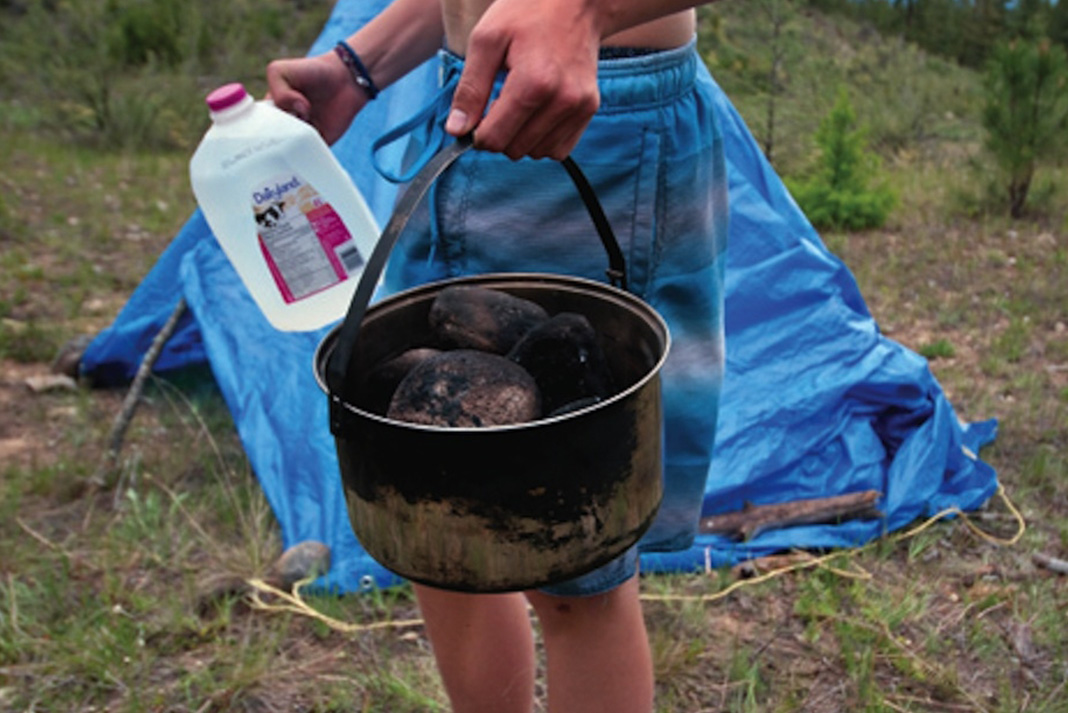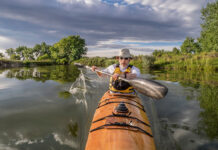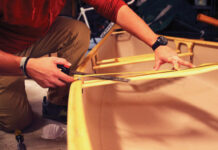The sauna (sow-na), or sweat, is a traditional pastime used for thousands of years. A sauna generally involves creating hot steam in a closed space by pouring water on a super-heated surface, and allowing the moist heat to relax muscles, ease the mind and renew your spirit. Whipping your friends with juniper boughs and leaping repeatedly into icy water are optional.
A sauna is an excellent way to pass a weather-bound day, while relaxing and getting clean in the bargain. After all, generations of First Nations people and Fins can’t be wrong.
How to build a backcountry sauna
Step 1: Choose site
The ideal sauna site is right next to a good deep-water jumping spot or swimming beach. You also want to be as close as possible to the spot where you will heat your rocks.
Step 2: Build the frame
Use driftwood or fresh-cut green boughs to create the sauna structure; set it up so there is just enough room for your group to sit inside without touching the hot rocks. Note: only use living trees if they are in the process of being washed away—do not cut trees from the forest. Drive the thick ends into the sand or block them with stones. Bend in and tie the thin ends together to form a small structure. The smaller the hotter!
Step 3: Add the shelter
Drape a large, four-by-four-metre tarp (that you don’t mind getting dirty) over the structure and seal the edges with sand, rocks or driftwood.
Step 3: Rock and roll
Collect grapefruit-sized or smaller stones for the sauna. Avoid softer, lighter, weathered and odorous rock and be sure to stay away from rocks that have been soaking in water, as they are more likely to explode. Look for crystalline igneous rocks or metamorphic rocks that are formed from igneous rock. For the geologically fluent, experts recommend peridotite, olivine, vulcanite and basalt. Stay away from sedimentary rocks such as sandstone or shale and collect your rocks from a dry area.
Collect a lot of firewood and light a large fire in an existing fire-pit or a low-impact spot. Let the fire burn down to a good bed of hot coals and place your rocks in the coals until they are red hot. Transfer the hot rocks into the sauna using a metal pot or bucket or pairs of strong, forked sticks. Add more rocks to the fire as replacements for those cooling in the sauna.
Step 4: Bliss
Strip down as bare as you dare, crawl into your sauna and seal the door. Pour water on the rocks and—ahhh… To make it a sweat in the native tradition, enter clockwise and exit the way you came in. Don’t forget to bring in water for drinking and extra for sprinkling on the rocks.
When you’re ready for a break, make a dash for your swimming spot to complete the thermotherapy routine—hot and cold immersion gives you a natural high and is said to strengthen the immune system. The hot rocks should be good for two or three repeats. If it’s cold out, crawl back inside the lukewarm sauna to dry off after your final plunge.
Step 6. Erase evidence
The backcountry or beach sauna is not a low-impact technique. Save the sauna for special occasions and suitable places—think ocean beaches, not alpine lakes. Make sure you’re getting rocks from a place where they won’t be missed and throw any blackened or cracked rocks out of sight into deep water. Burn your fire down to white ash and put it out before you leave.
Sauna rules:
1. Stay hydrated—drink at least a cup (250mL) of water every 15 minutes.
2. Exit sauna to cool down every 10 to 15 minutes.
3. Try a cold-water dunk at least once!
4. Clothing optional.
These articles originally appeared as “DIY Backcountry Sauna” in Canoeroots and Family Camping‘s Summer 2009 issue and “Build Your Own Beach Sauna” in Adventure Kayak‘s Summer 2006 issue.Subscribe to Paddling Magazine’s print and digital editions here, or browse the archives here.
True “glamping.” | Photo by: Dave Quinn








